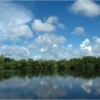These are the specie called the Rusty Crayfish or Orconectes Rustica and they've always been that olive drab with rusty reddish brown on them. However, a pair out of the 5 in my tank have started turning a dark blue with green hue to them and I've had one in another tank turning pink. Has anyone had wild crayfish turn blue/blue-green on them before? I have shown the blue one and one that has remained the color it was in the wild. Both photos were taken on the same day and in the same tank. As for the food they eat, it's blood worms, Mysis shrimp and once in awhile, minnow fry and they seem to be doing well with it as I've had all 5 crays molt twice since October 1st.
Any ideas on what might cause these color changes?











